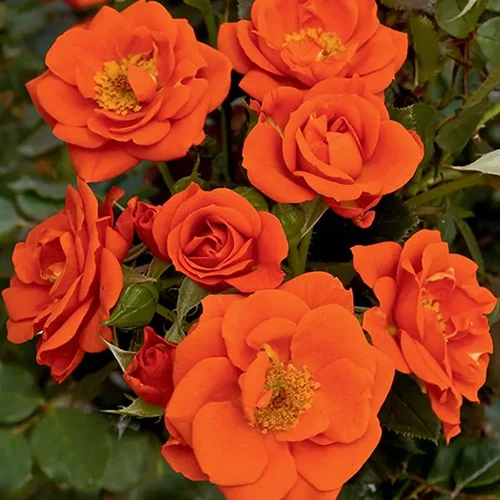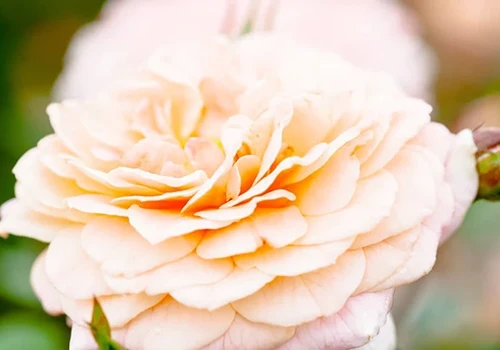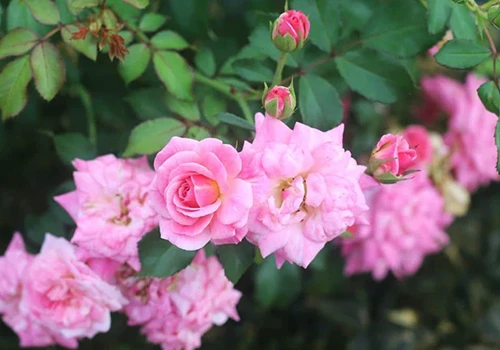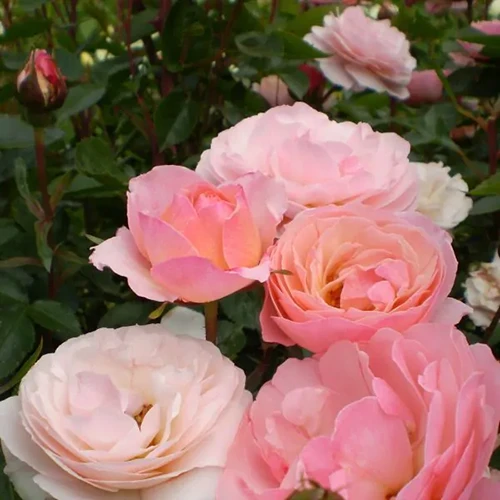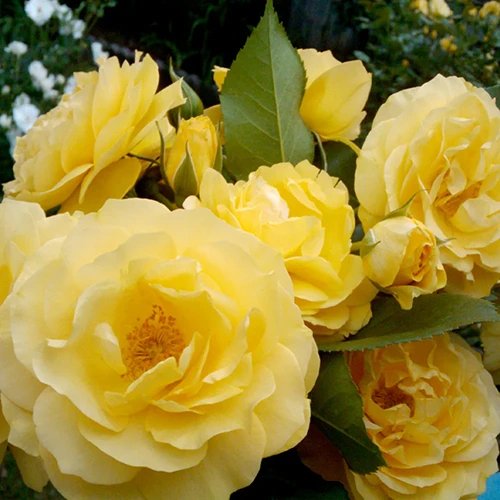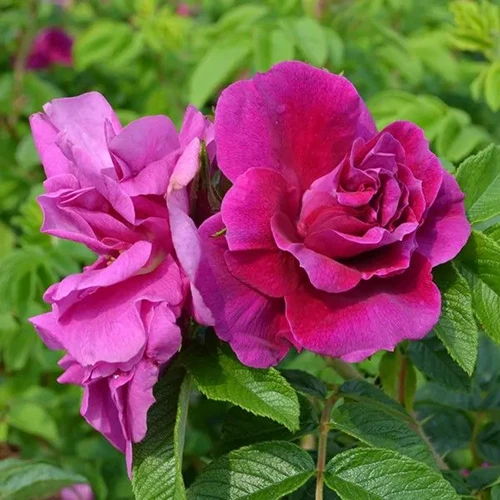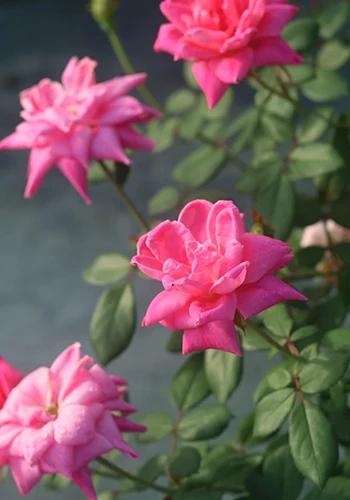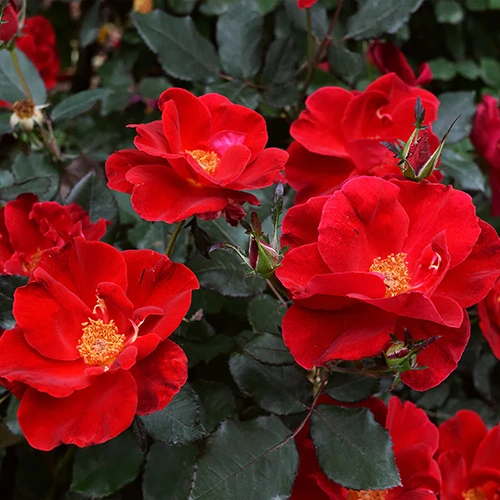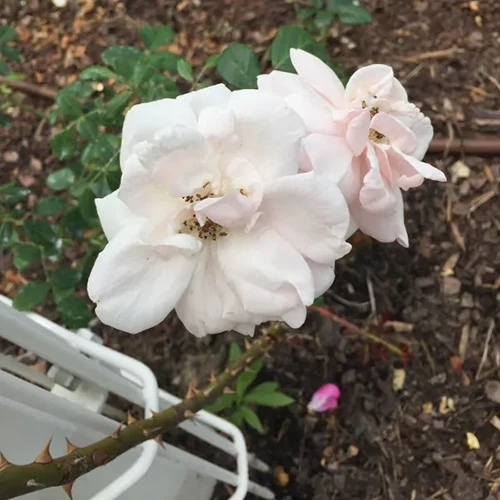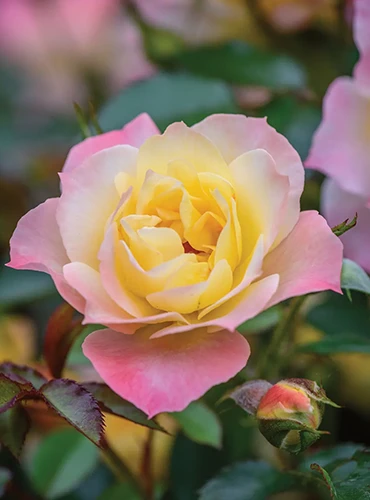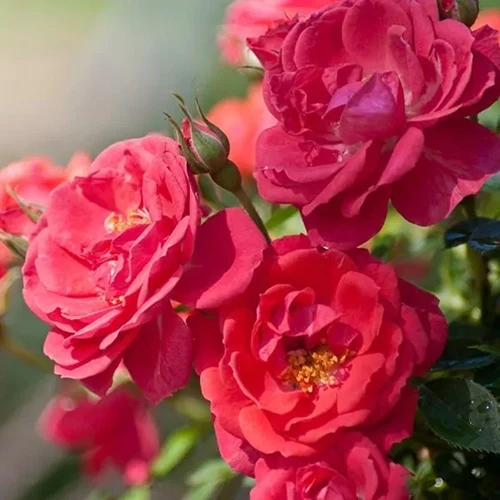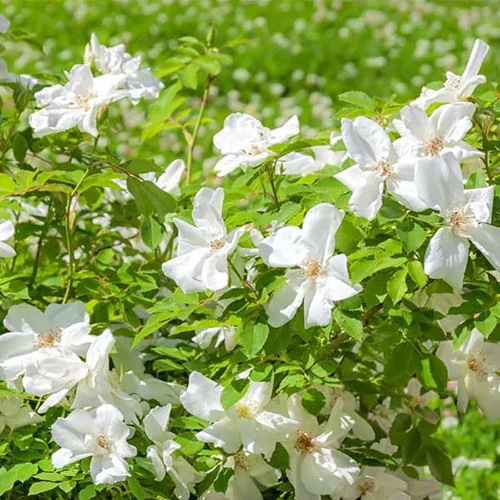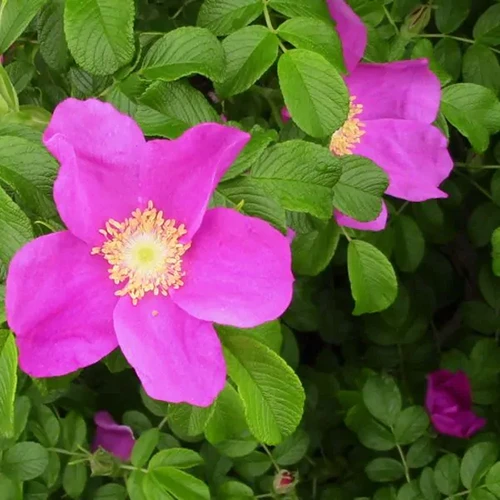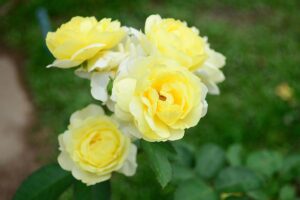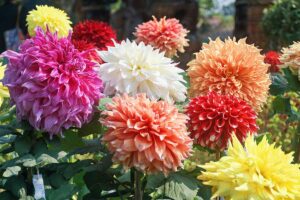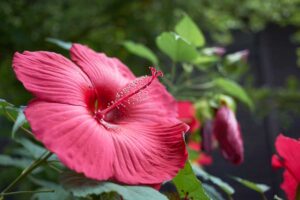I think a lot more gardeners are learning the importance of gardening without the use of chemicals.
While there is certainly a time and a place to break out the big guns, overuse can throw off the balance of your garden, which itself can lead to even more pest infestations and diseases. It becomes a vicious cycle.
But some plants, like roses, have a reputation for needing gallons and gallons of chemicals to keep them looking their best.
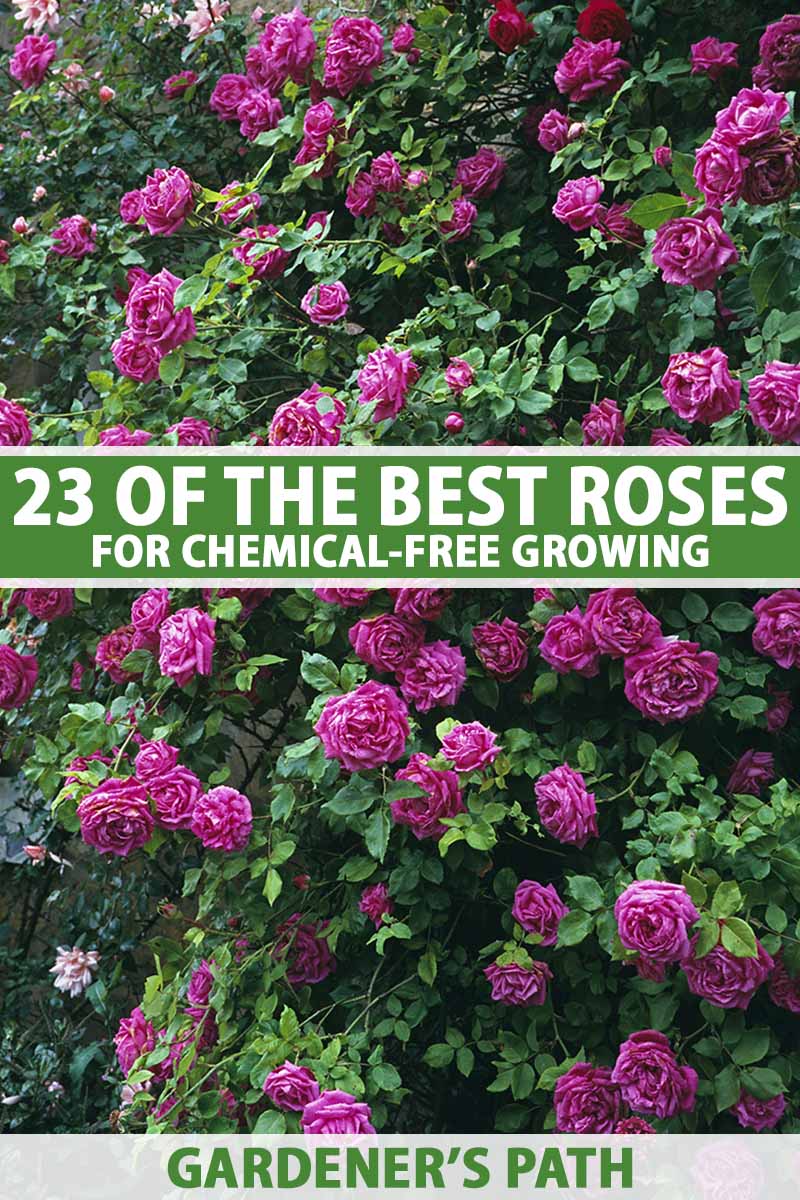
We link to vendors to help you find relevant products. If you buy from one of our links, we may earn a commission.
Maybe some of the roses of yore deserve that reputation, but we have some excellent new hybrids that are truly carefree.
And that’s not to disparage antique roses – on the contrary, some of our oldest cultivars have proven themselves to be sturdy stalwarts as well.
In fact, growing roses without chemicals begins with selecting the right cultivars.
You might be able to keep any hybrid alive without the use of pesticides and fungicides, but it’s going to be a steep uphill battle.
If you pick sturdy, tough, disease-resistant types to begin with, your battle will be more of a slow ride down a gentle slope.
If you love roses but hate chemicals, you’re in the right place. In this guide, we’ll introduce 23 amazing options. Here they are, alphabetically:
23 of the Best Roses for Chemical-Free Gardens
One of the not-so-secret secrets to choosing chemical-free roses is to look for those that are disease resistant.
Wild roses, which are genetically closer to the original roses that grew for millennia without any human intervention, will obviously require less pampering. But who wants to garden with only species roses?
Hybrid teas, on the other hand, tend to be more prone to disease.
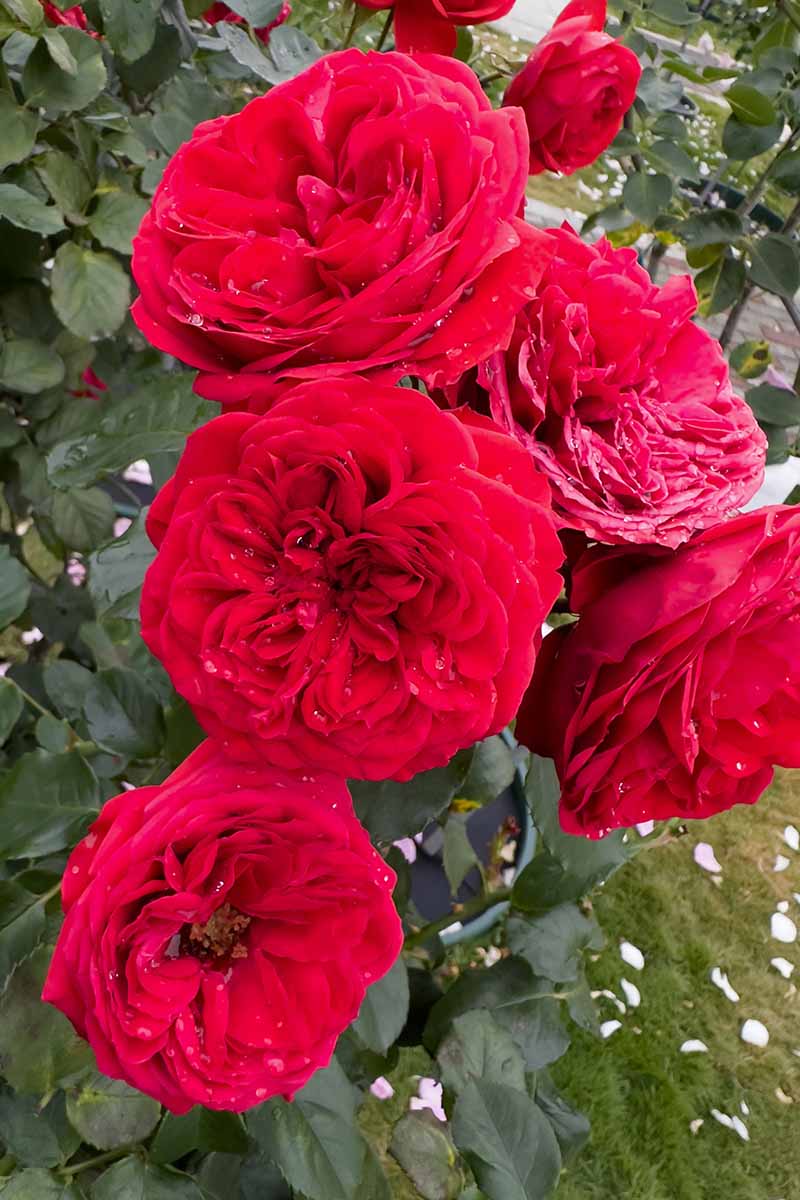
Location matters, too. A rose that is going to thrive in Arizona probably won’t be happy in Maine.
Similarly, growers in New Mexico probably don’t dread the words “black spot,” but they know all about spider mites, which love hot, dry conditions.
Southwestern gardeners will find that ‘Beverly’ is happy in their climate, while northeasterners will probably find ‘Therese Bugnet’ is happier in their neck of the woods.
Reach out to your local rose society to find which varieties they recommend for your area.
The location in your yard also matters. Yes, roses can grow in some shade, but they will always, always be happier in full sun. If your goal is chemical-free gardening, you’ve gotta plant in full sun.
You should also set your plants up for success by planting them in loamy, well-draining soil, making sure they’re well-spaced, and giving them the amount of water they need.
Let me also clarify that chemical-free doesn’t mean you won’t ever have to do any sort of intervention.
You’ll probably need to do some judicious pruning and you should follow good gardening practices like watering in the morning at the soil level. You might also need to dip into dormant oils or spraying your plants with water to knock off aphids.
Alright, enough talk. Let’s look at some of the most tried-and-true roses for a chemical-free garden.
1. Alister Stella Gray
While the flowers on ‘Alister Stella Gray’ aren’t huge, they make up for their lack of size with complexity.

As they open, the tightly scrolled buds are egg-yolk orange before unfurling into quartered, soft yellow blossoms. As they fade and drop, they transition once again to a pale cream.
It’s easy to see why this one has been consistently cultivated since 1854.
The blossoms appear in small groups on long stems and repeat bloom throughout the season.
This rambling noisette can grow as a tall, free-standing shrub, or it may be trained up a pillar or wall in Zones 5b to 10b. It will eventually reach up to 15 feet tall, but you can prune it to keep it shorter.
2. All a Twitter
Sweet and petite ‘All a Twitter’ will have the neighborhood talking. At just two feet tall and wide, she’s small but mighty.
The bush is covered in large clusters of semi-double blossoms in a brilliant, fiery orange color and these appear in flushes throughout the growing season.
Its petite size means this cultivar works well in containers, but it’s also ideal for chemical-free gardens in USDA Growing Zones 4 to 10 because it’s extremely disease resistant.
Start the conversation by heading to Nature Hills Nursery to purchase a live plant in a #2 container.
3. Carefree Beauty
One of the names you’ll see a lot on this list is Dr. Griffith Buck. What makes his cultivars worthwhile? Their disease resistance, shade tolerance, and general hardiness.
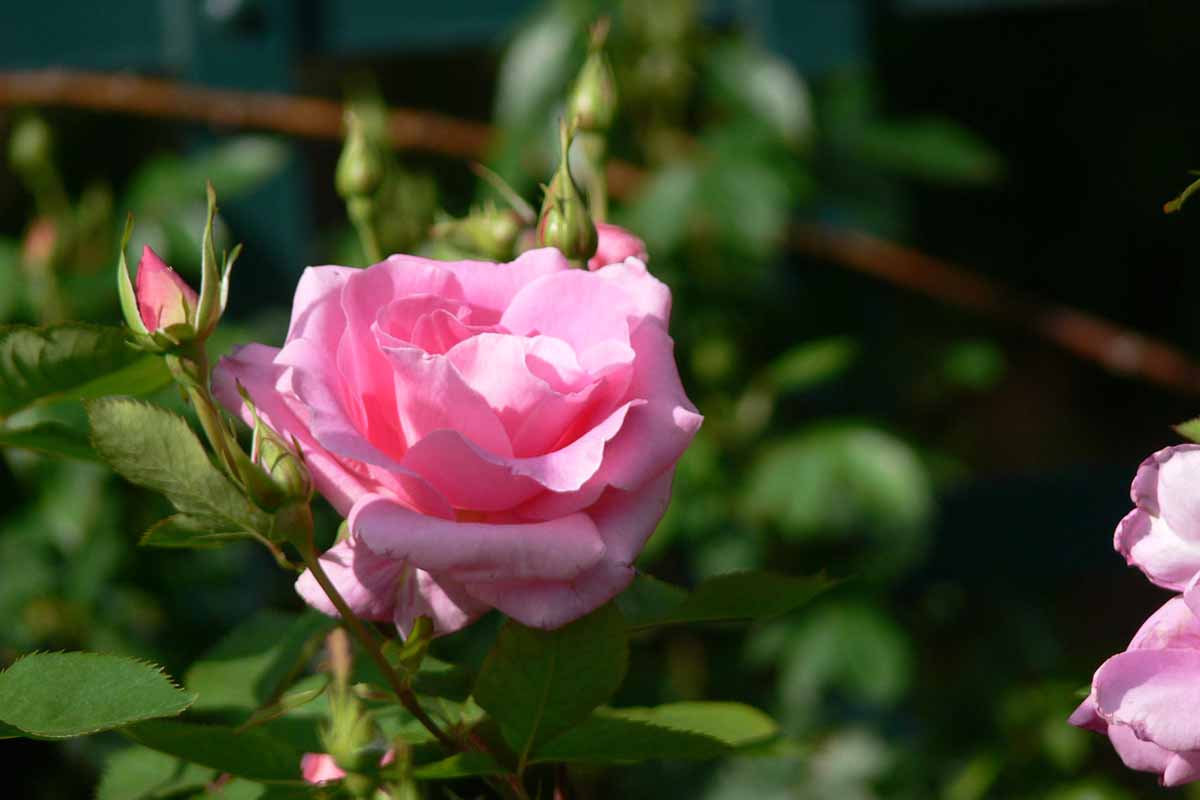
Dr. Buck had an interesting philosophy when he bred a rose. He would allow the plant to grow without any fungicides or pesticides, and without winter protection.
If it survived, it continued in the breeding program. If it didn’t, it was out.
His method has resulted in some extremely tough roses that are also incredibly beautiful. Some roses ask you to compromise hardiness for size or fullness, but not his cultivars.
‘Carefree Beauty’ is one such creation. At five feet tall, it’s a manageable size, but the large blossoms are double, bloom perpetually, have a strong and sweet fragrance, and appear singly or in small groups. Both red and pink options are available.
4. Cinderella
One look at this sweet lady all dressed up in her finest ballgown, and you’ll understand why any prince would be willing to scour the land to find her.
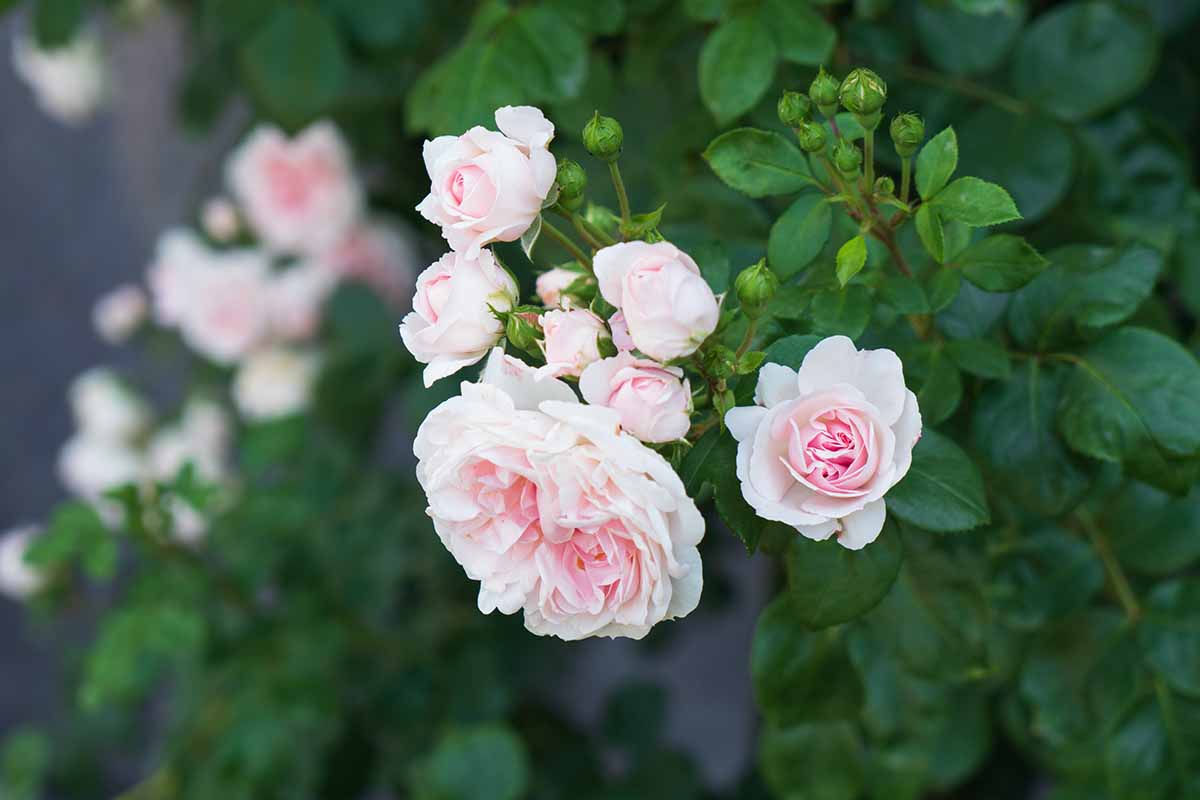
‘Cinderella’ is a Krodes climber with sweet pink clusters of medium-sized, very full blossoms that appear in flushes throughout the growing season.
It’ll bloom better if you deadhead though. In Zones 4 through 9, this plant will grow about six feet tall.
While this cultivar looks like a classic old rose, complete with a mild rose and apple fragrance, it’s actually a newer hybrid that has made a huge splash on the market since it was introduced in 2006.
5. Dark Desire
Once you see the nearly black buds unfurling into vibrant violet-red blossoms, you’re going to be hankering for this rose.
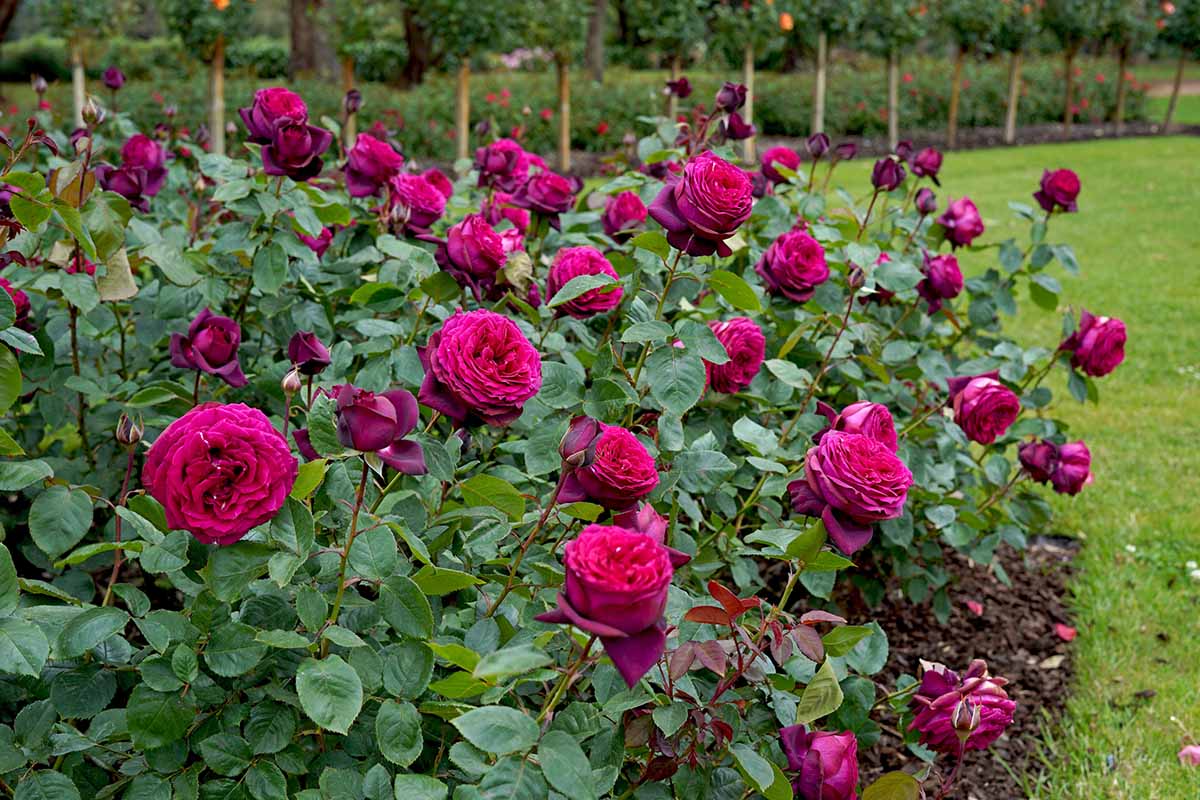
Bred by Kordes in 2003, the large, very full blossoms are heavily fragrant and smell of sweet citrus, peach, and old rose. They’ll appear in large flushes throughout the summer and fall.
This hybrid tea stays under five feet tall. Just don’t get too close as you fall in love – this shrub is armed with multitudes of vicious thorns.
Those brave enough for the dark delights can grow this rose in Zones 5 through 9.
6. Distant Drums
Given the chance, I’m determined to see ‘Distant Drums’ growing in every rose garden.
The unique mauve, copper, and blush blend of hues in the petals is simply unlike anything else out there.
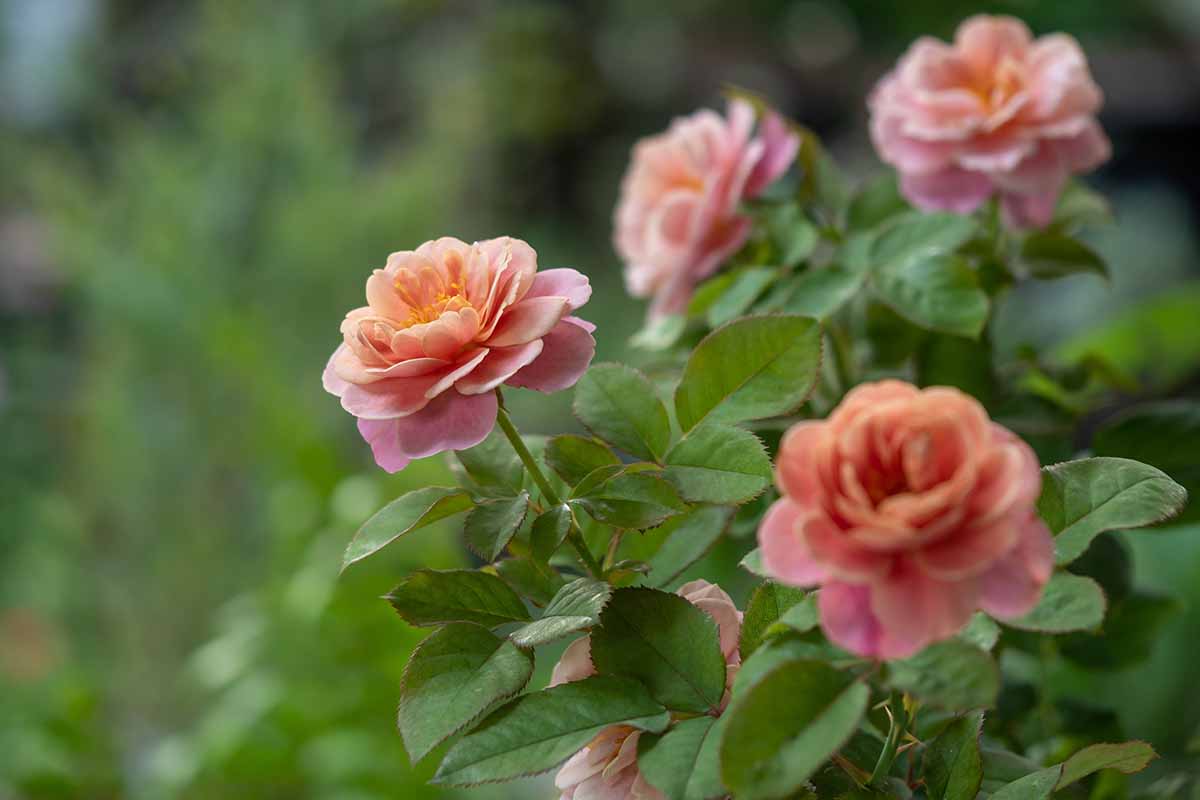
These offer a constantly changing display of colors, starting with the reddish-pink buds that open to reveal pink, copper, and mauve blossoms.
Finally, they fade to blush and fall from the plant.
Bred by Dr. Griffith Buck, the full flowers are borne singly on a three-foot-tall and four-foot-wide floribunda shrub that blooms continuously.
It’s hardy in Zones 5b through 9b, and you can leave the chemicals in the cupboard because you won’t need them here.
7. Drift
The Drift series was seemingly bred with chemical-free growers in mind.
Sold as “ground cover” roses, they grow low and wide, and bloom from spring until the frost – even if you don’t bother maintaining them at all.
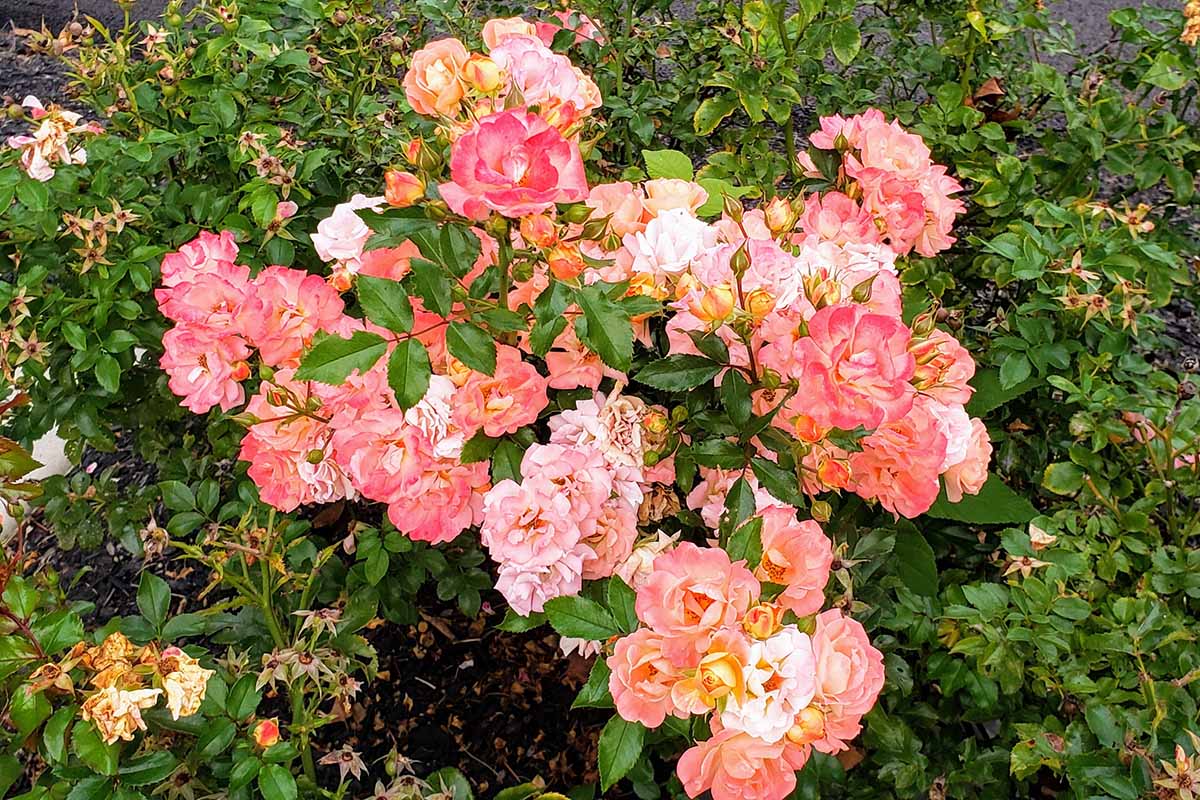
They’re disease-resistant and come in a range of appealing colors like pink, apricot, cream, coral, yellow, peach, red, and white. They are suitable for Zones 4 to 11.
If I had to pick a favorite, Apricot Drift® would be up there because of its orange-pink double blossoms that grow in large sprays.
It looks like a classic old world choice with a modern ground cover habit.
Perfect Plants Nursery carries it in a three-gallon container. You can also find Apricot Drift® available at Nature Hills Nursery in a quart-size container.
But okay, wait. On second thought, maybe Sweet Drift® is my favorite? It has masses of perfectly pink double flowers.
You can bring one of these home from Perfect Plants Nursery in a three-gallon container as well.
8. Easy Elegance
With “easy” in the name, you know it’s gotta be carefree. This series of roses is bred to be planted and forgotten. But that’s easier said than done.
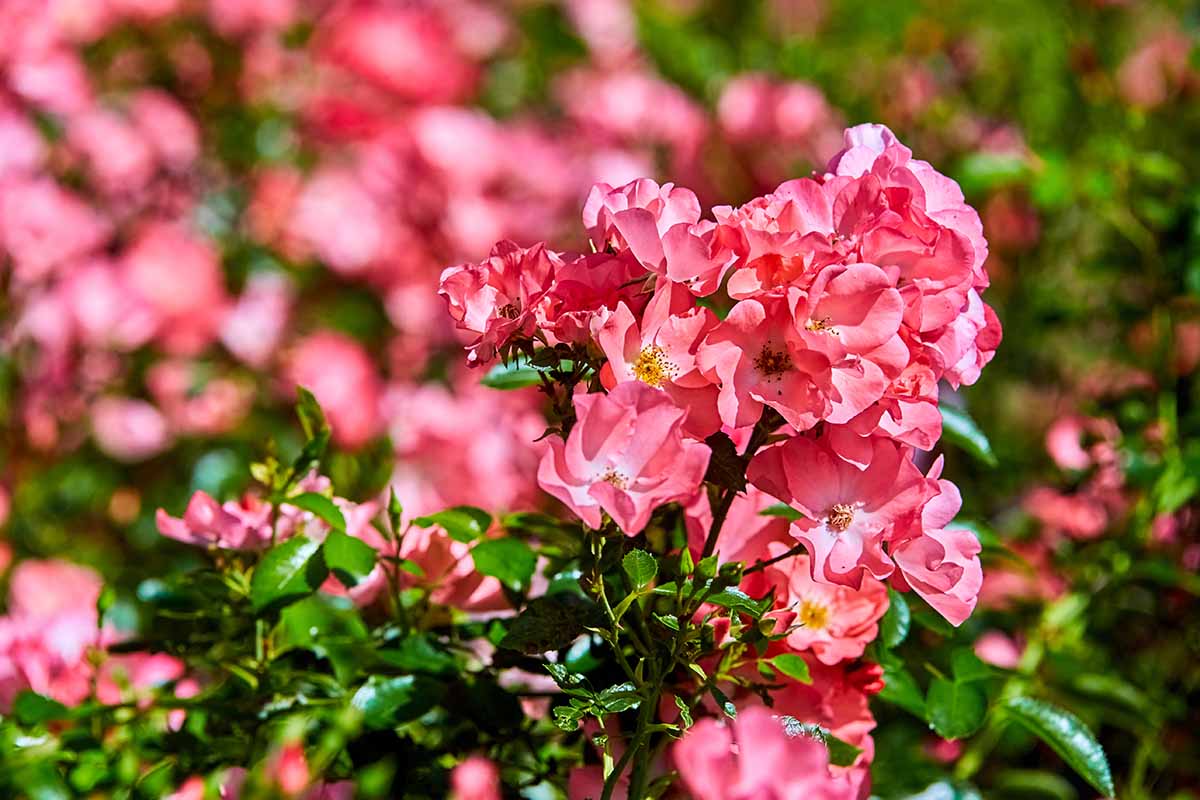
Sure, you can forget worrying about maintenance, but the vibrant flowers are impossible to ignore!
Self-cleaning with perpetual blossoms, the flowers won’t quit on a shrub that says under two feet tall. It’s also tough enough to survive the winter chill as far north as Zone 4a.
Best of all, the breeder notes that these roses have “no complicated pruning or chemical applications required.”
Nature Hills Nursery carries the easygoing ‘Calypso’ peachy-pink color in #2 containers.
9. Fiji
Typically, if you want to avoid black spot and you aren’t willing to use chemicals, you’ll need to grow a rugosa. But ‘Fiji’ is practically immune, and it’s a hybrid tea.
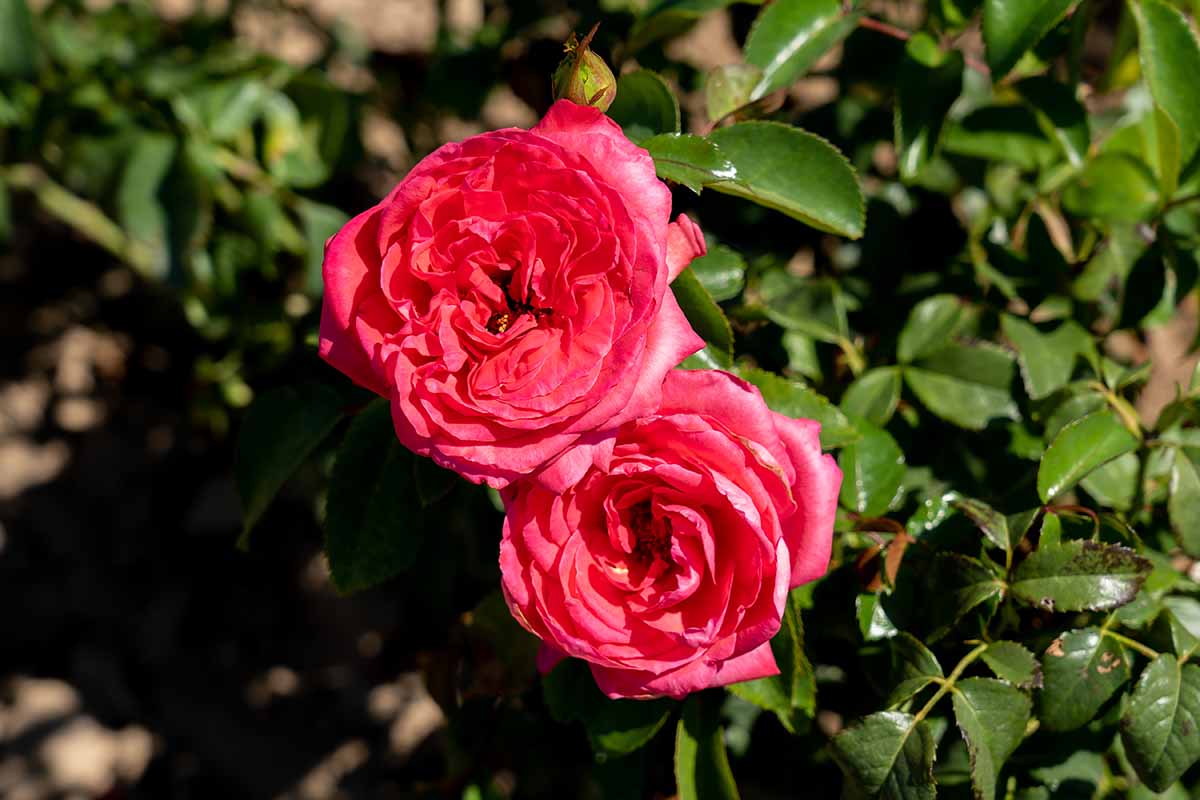
It blooms in flushes with clusters of large, full flowers in a cherry-pink hue. The arching shrub grows about four feet tall.
‘Fiji’ is part of the Eleganza series, which is as fabulous as it sounds.
These shrubs are bred to be extremely disease resistant without compromising on the floral display, and ‘Fiji’ is one of the finest. Grow this hybrid tea in Zones 5 to 10.
10. Frida Kahlo
Art can be elegant and beautiful, but that doesn’t mean it’s without substance.
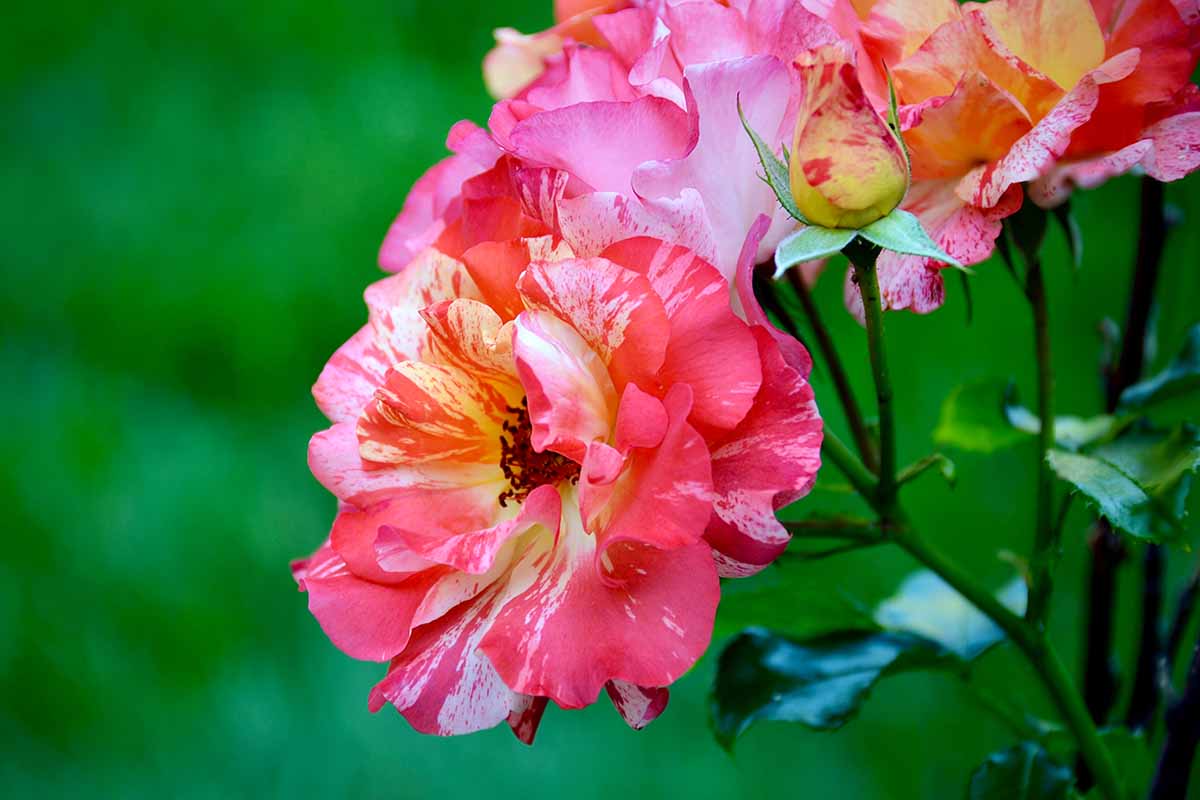
Disease-resistant and extremely vigorous, ‘Frida Kahlo’ is as tough as she is beautiful.
The vibrant reddish-orange, full blossoms are streaked with flecks of buff tan on a petite, three-foot-tall shrub.
The blossoms grow in flushes of small clusters or solitary flowers right through the fall.
She’s truly a work of art worthy of her namesake, and worth having in any garden. Bring home a live plant in a #2 or #3 container from Nature Hills Nursery for growing in Zones 5 to 9.
11. Julia Child
I’ll admit it, sometimes a good name makes me biased towards a plant.
I adore Julia Child, and I think these buttery yellow blossoms, named for the woman who proclaimed that anything could be made delicious with enough butter, do her justice.
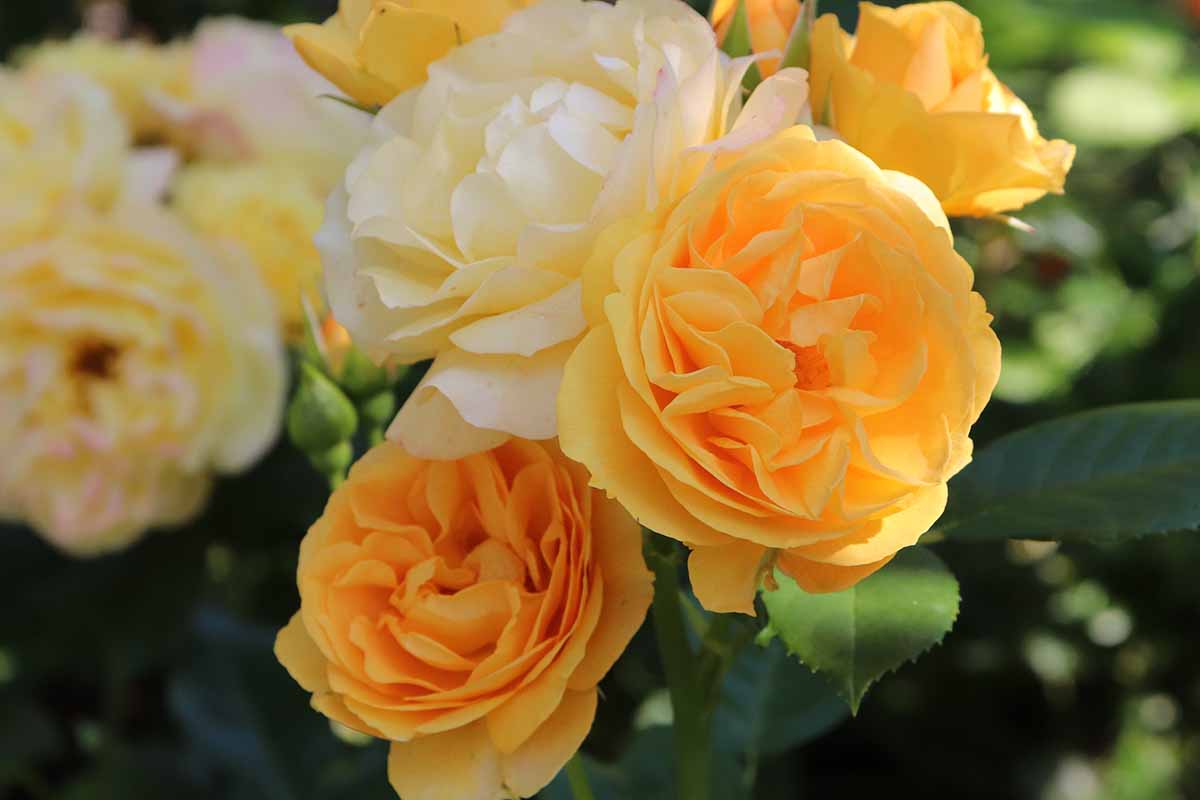
But you could call this rose ‘WEKvossutono’ (its registered name), and I’d still love it.
The large, full flowers are borne singly or in small clusters, perfect for cutting and dressing up the dinner table. This cultivar blooms continuously throughout the season.
The shrub stays under three feet tall, and the blossoms have an intense licorice scent that is beyond delightful.
If you’re as enamored as I am, get yourself a live plant in a two-gallon container at Fast Growing Trees.
Grow her in Zones 5 to 10. Bon appetit!
12. Hansa
Rugosa roses are tough as nails, thriving in heat, drought, salty conditions, and even shade, but some of them have lackluster blossoms. Well, not ‘Hansa.’
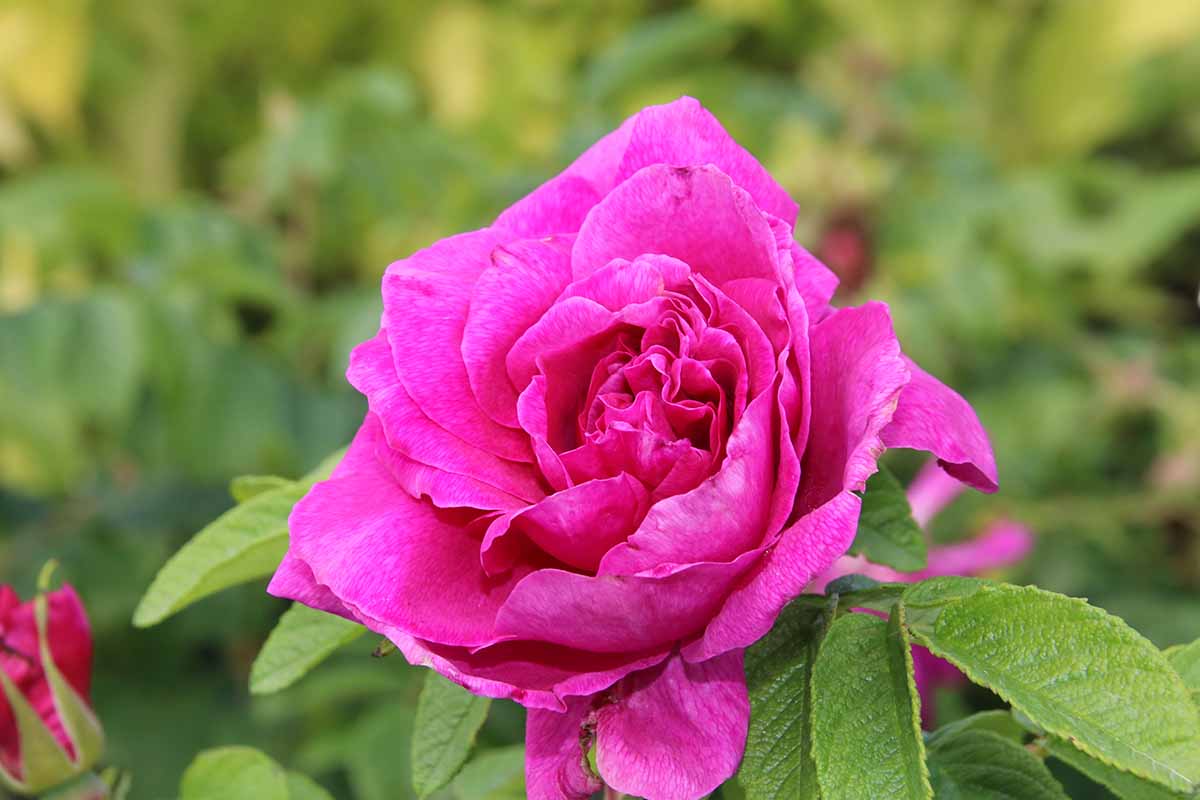
The striking pink-purple double flowers have a bold clove scent and appear in large clusters. This cultivar blooms once in the early summer and then again in the late summer.
Then along come the bright red rose hips, adding another season of color that lasts into the winter – if the wildlife doesn’t get them all first.
Hardy from Zone 3b to 7b, ‘Hansa’ is practically immune to pests and diseases.
Nature Hills Nursery carries ‘Hansa’ in #3 containers if you want to add it to your garden.
13. Knock Out
Knock Out roses, you could argue, are the ones that brought roses back into home gardens after they began to fall out of favor, and that’s because they’re practically maintenance-free, tough as nails, and require zero chemicals to keep happy.
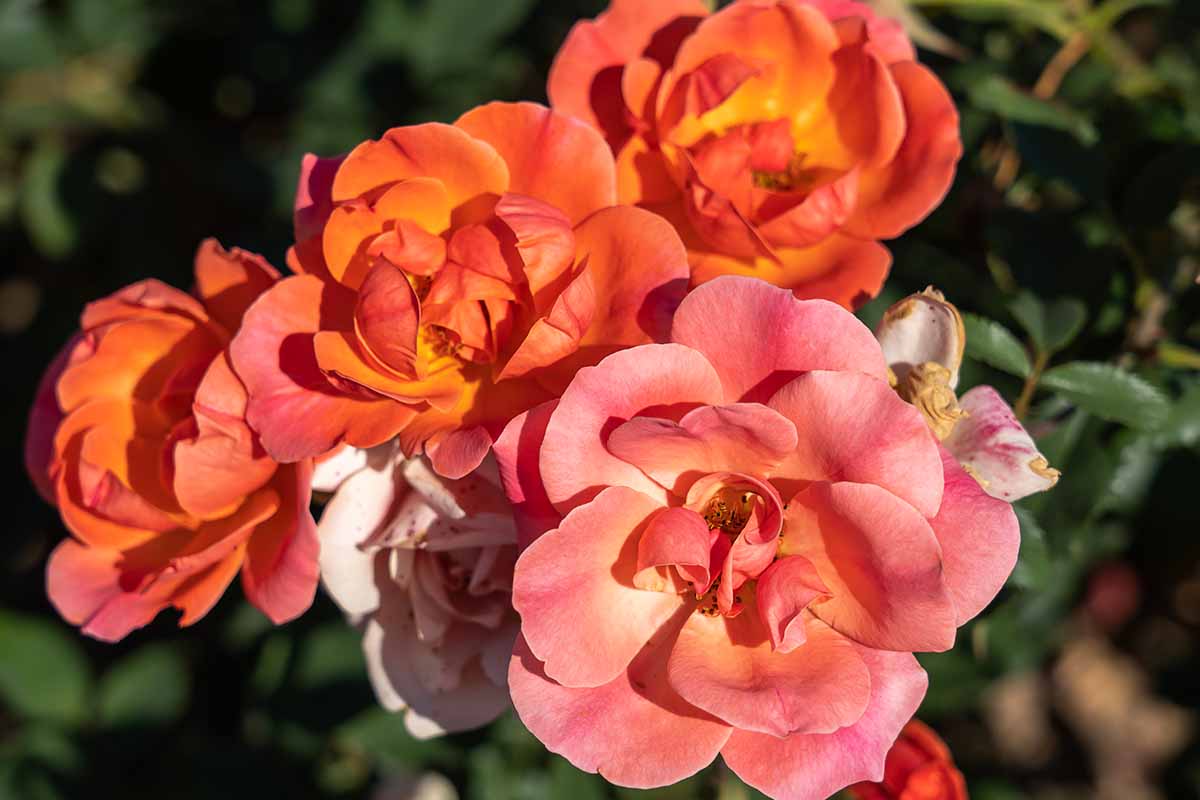
They bloom constantly from spring through fall and grow in Zones 5 to 10.
The biggest complaint people have about these roses is that the flowers are smaller and simpler than those of some of the showier types out there.
Nowadays, though, the breeder has added larger, double blossoms to the Knock Out series that have that classic rose look.
Right now, you can find these more impressive options in red and pink. To bring home the pink version, visit Perfect Plants Nursery to purchase a one- or three-gallon plant.
14. Kosmos
A gorgeous Kordes floribunda, ‘Kosmos’ has large, creamy, very full flowers with a peach center.
They appear in clusters and repeat bloom throughout the season for an ongoing display in Zones 6b to 9b.
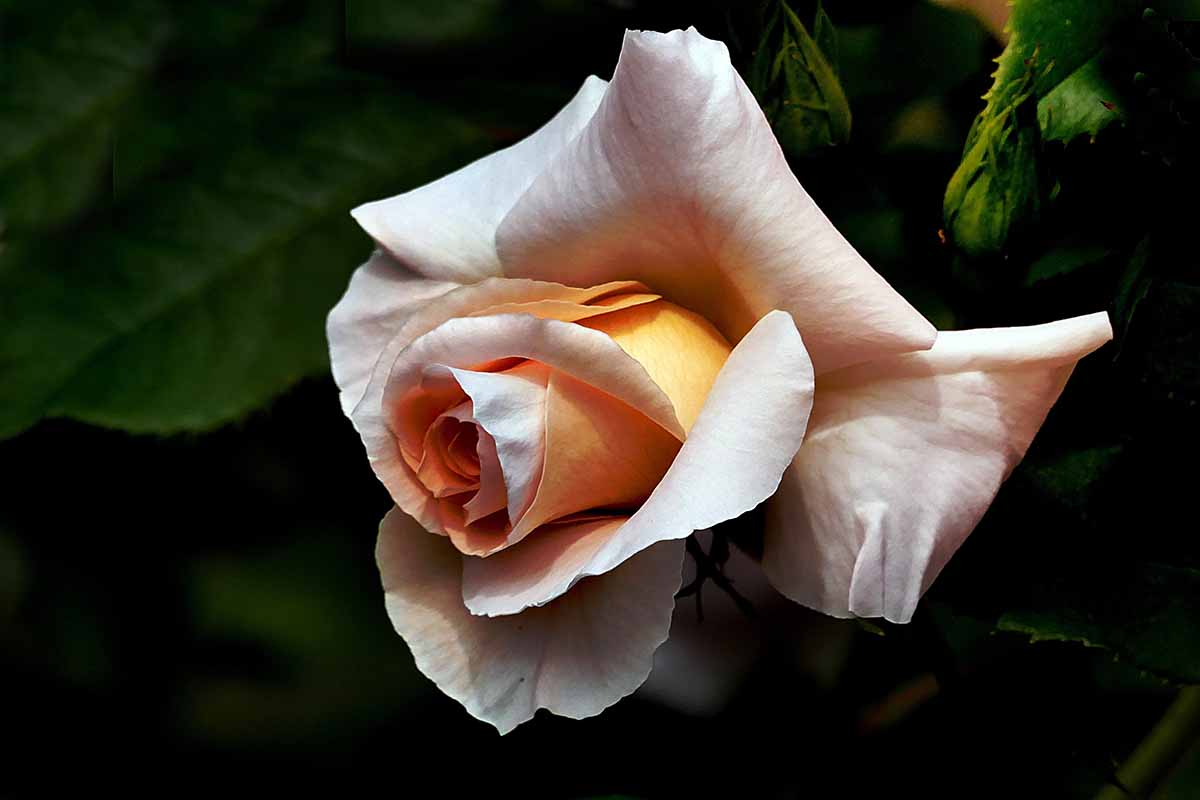
The bush can grow nearly five feet tall, and the display doesn’t end in the fall when the flowers stop. The hips are large and bold red.
Since it was bred in 1997, ‘Kosmos’ has consistently proven to be extremely vigorous and disease-resistant.
Basically, you can sit back and enjoy the display without resorting to anything more than a seasonal pruning.
15. Mandarin Ice
You might notice a few names continually popping up on this list, and one of them is Kordes.
That’s because the well-known breeder has made it their mission to create disease-resistant shrubs that are perfect for chemical-free gardens.
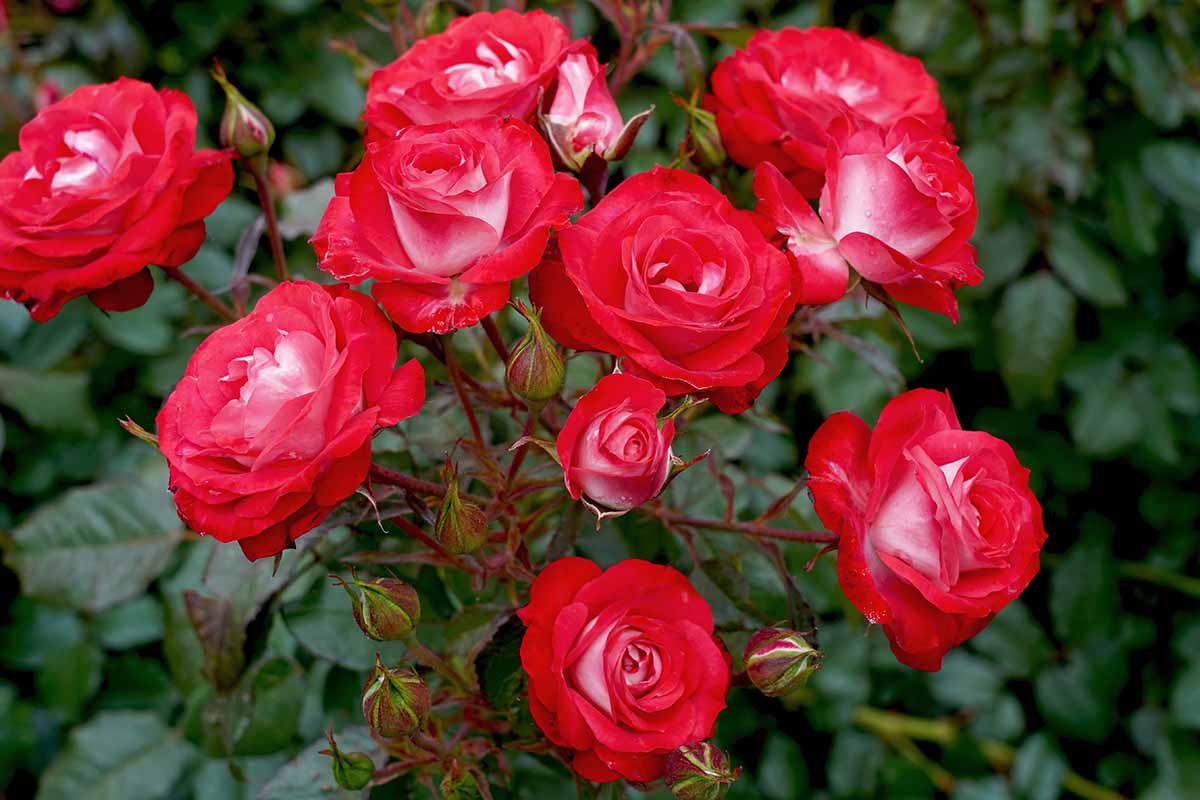
‘Mandarin Ice’ was bred by Kordes in 1999, and they must have known they were onto a winner.
The medium-sized, semi-double blossoms form in big clusters on a three-foot-tall shrub.
Each flower is bright red on top and pinkish-white on the reverse, followed by bright red hips in the fall. It’s a truly unique display.
This rose has won award after award, including the Hague Golden Rose in 2011, the Kortrijk Silver Medal in 2010, the Den Haag Silver Medal in 2010, and the Baden-Baden Silver Medal 2009.
If you live in Zones 5 to 9, this rose will keep thriving even without chemicals.
16. Miracle on the Hudson
Remember in 2009 when a bird strike brought down a US Airways Flight and it was forced to make an emergency landing in the Hudson River?
That event was immortalized by this mildly fragrant, dark red rose.
With semi-double blossoms that cover the shrub from head to toe from spring until fall, it’s a beautiful reminder of the miraculous nature of life. It’s also exceptionally hardy and will grow in Zones 3 to 9.
To bring this memorial into your own garden, visit Fast Growing Trees to purchase a three-gallon live plant.
17. Mister Lincoln
‘Mister Lincoln’ is just cute, with classic red blossoms. But that’s not why this four-foot-tall hybrid tea shrub is so incredibly popular. It’s because it’s as tough as nails.
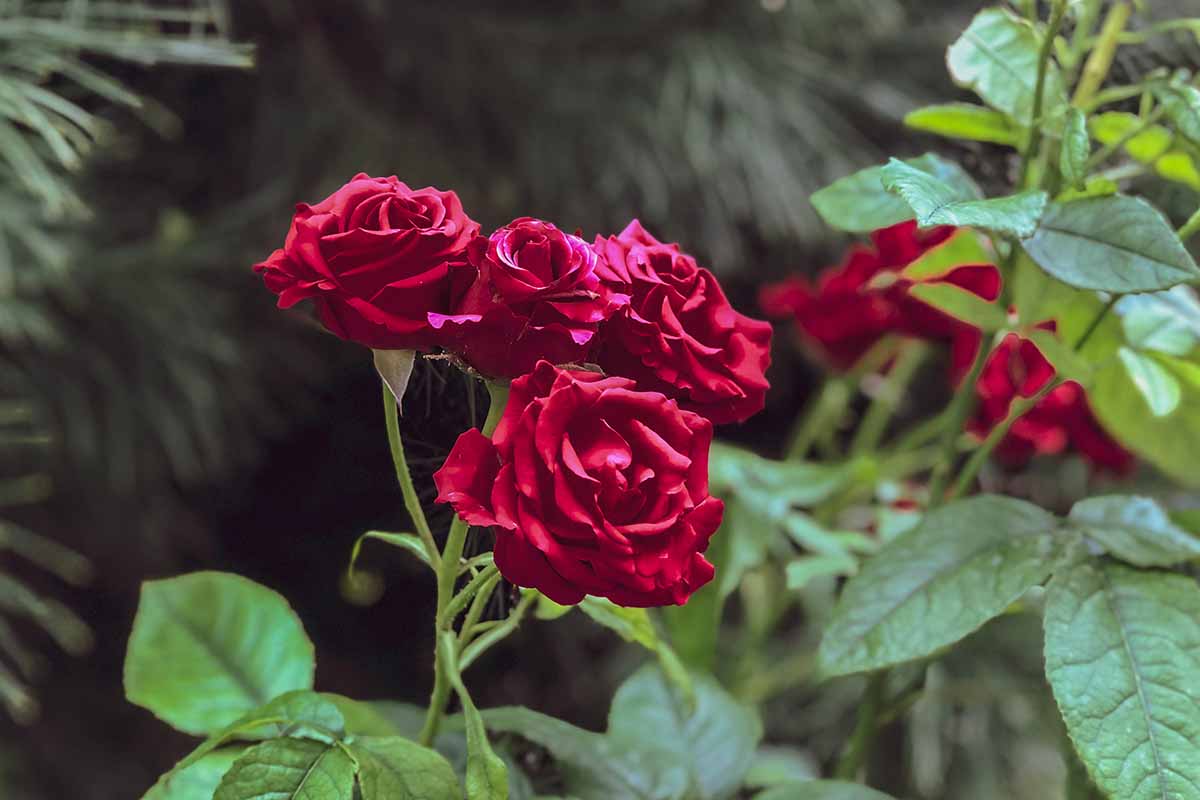
When breeders need a rootstock option, for years, they’ve turned to ‘Mister Lincoln’ because it’s disease-resistant, adaptable, and vigorous.
In fact, sometimes the roots are so vigorous that they’ll take over the scion, which is the upper part of a grafted plant.
Suddenly, people who thought they were growing something else now have a ‘Mister Lincoln’ in their yard.
You can’t go wrong with this one if you want to garden without chemicals. Grab one for your garden at Nature Hills Nursery.
18. Nearly Wild
Like a wild rose but more mild-mannered, ‘Nearly Wild’ won’t go all rangy and leggy, spreading where it’s not welcome. It has beautiful pink, single blossoms on a petite, three-foot-tall shrub.
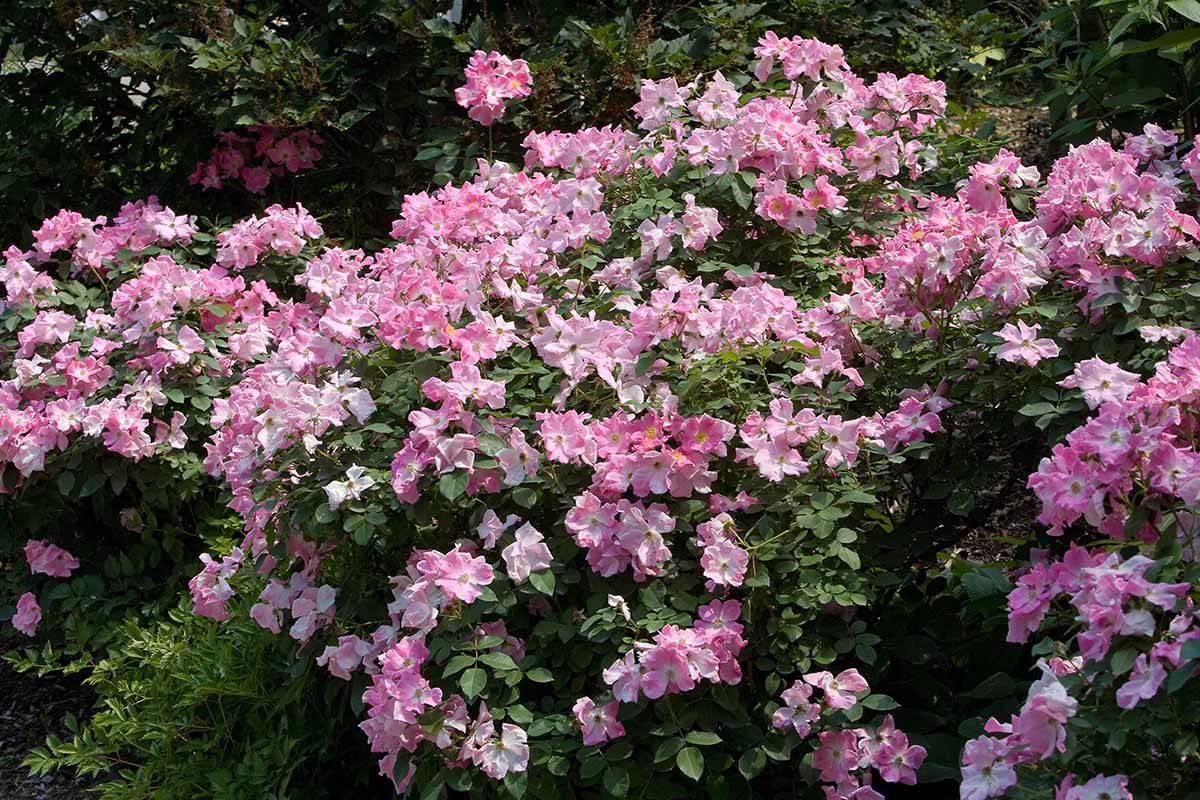
As with its fully wild counterparts, it’s extremely disease-resistant, tolerant of a range of environments, cold hardy down to Zone 4, and it features bright orange hips in the fall.
‘Nearly Wild’ is a continual bloomer that benefits from deadheading and regular pruning.
Ready to walk on the wild side, but not too far? Snag ‘Nearly Wild’ from Nature Hills Nursery in a #3 container.
19. New Dawn
The sun shone down on the growers who brought ‘New Dawn’ to market nearly 100 years ago.
This pink beauty has clusters of very full blossoms, and it blooms continually and reliably with sweet-smelling flowers from spring through fall.
This climbing rose can reach 15 feet tall in Zones 5 to 11, making it a killer option for a trellis or arbor near a patio.
‘New Dawn’ was the foundation for many of the modern perpetual climbers, which says something about its robust, disease-resistant nature.
You can pick one up from Nature Hills Nursery in a #3 container.
20. Oso Easy
Oso Easy is a series of floribunda roses bred to be tough enough to thrive without pesticides or fungicides. The shrubs stay petite, under 36 inches tall.
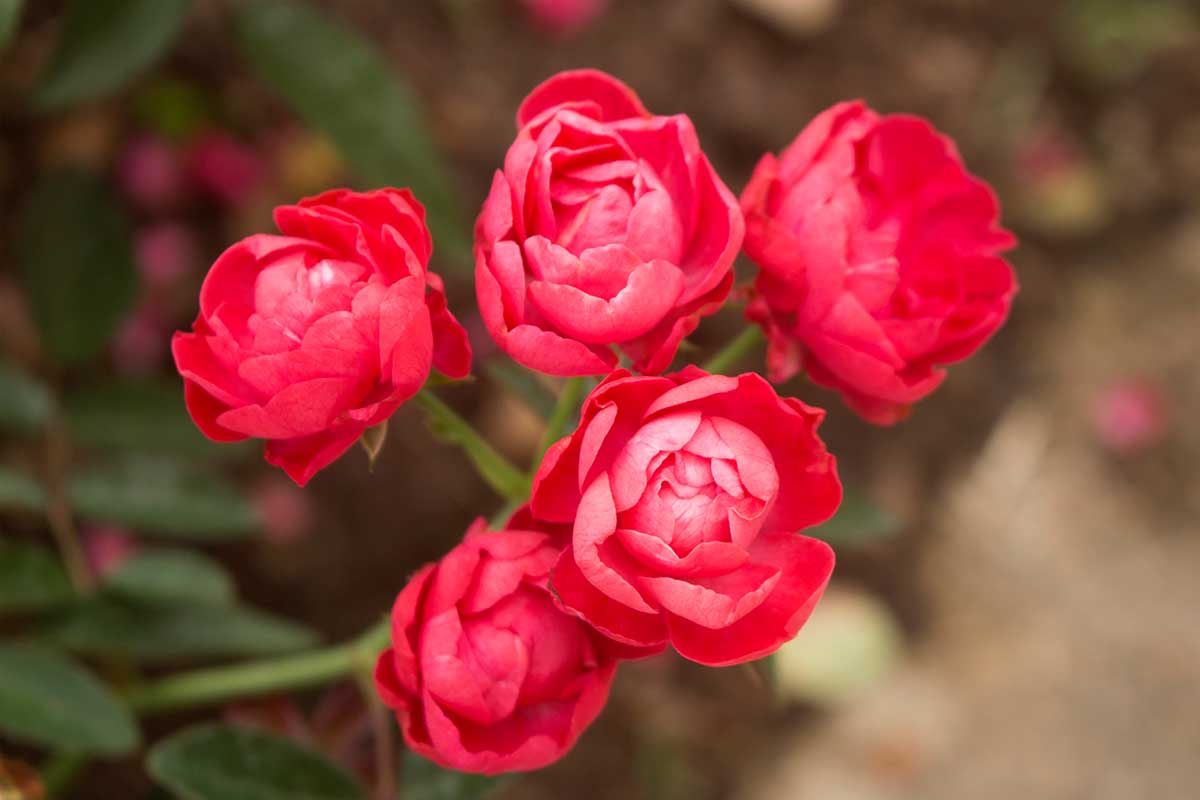
I think ‘Italian Ice’ is particularly nice, with mouthwatering pink and yellow double blossoms on an adorably sweet foot-tall and 20-inch-wide shrub.
This sweet treat blooms from late spring through the fall without stopping or melting in the sun in Zones 5b and up.
If your mouth is watering for some ‘Italian Ice,’ head to Burpee for one of your own.
‘Mango Salsa’ is also deliciously delightful, with bright coral double flowers that appear in clusters in repeat flushes all summer long.
This one grows to a respectable two to three feet tall and wide.
If this bold, bright rose is more your style, Nature Hills Nursery has it available in #3 containers.
21. Rugosa
Beyond Knock Outs or Drifts, rugosa roses are one type you can pretty much count on growing well without chemicals. They are so incredibly tough, it seems like nothing bothers them.
Rosarians joke that if you grow your shrubs in poor conditions, you’re growing fungal spores with a side of roses. But rugosas will avoid disease even in shady or poorly draining spots.
You can readily find the original pink and a snow white version, and both grow happily pretty much anywhere in Zones 3a to 10a. I guess the one downside is that they can be a little aggressive sometimes.
The shrubs are about four feet tall and spread up to 10 feet, but they’ll send out suckers that can spread indefinitely.
After the semi-double flowers fade, huge, juicy, reddish-orange hips appear and these persist on the bush until either wintery conditions or the birds get them, whichever comes first.
‘Alba,’ the white option, is available for purchase at Nature Hills Nursery as a bare root or a live plant in a #2 container.
The original pink is also available at Nature Hills Nursery, with the same options.
22. Serendipity
‘Serendipity’ has a coral center and large, pale blush petals on the exterior of the large, double blossoms.
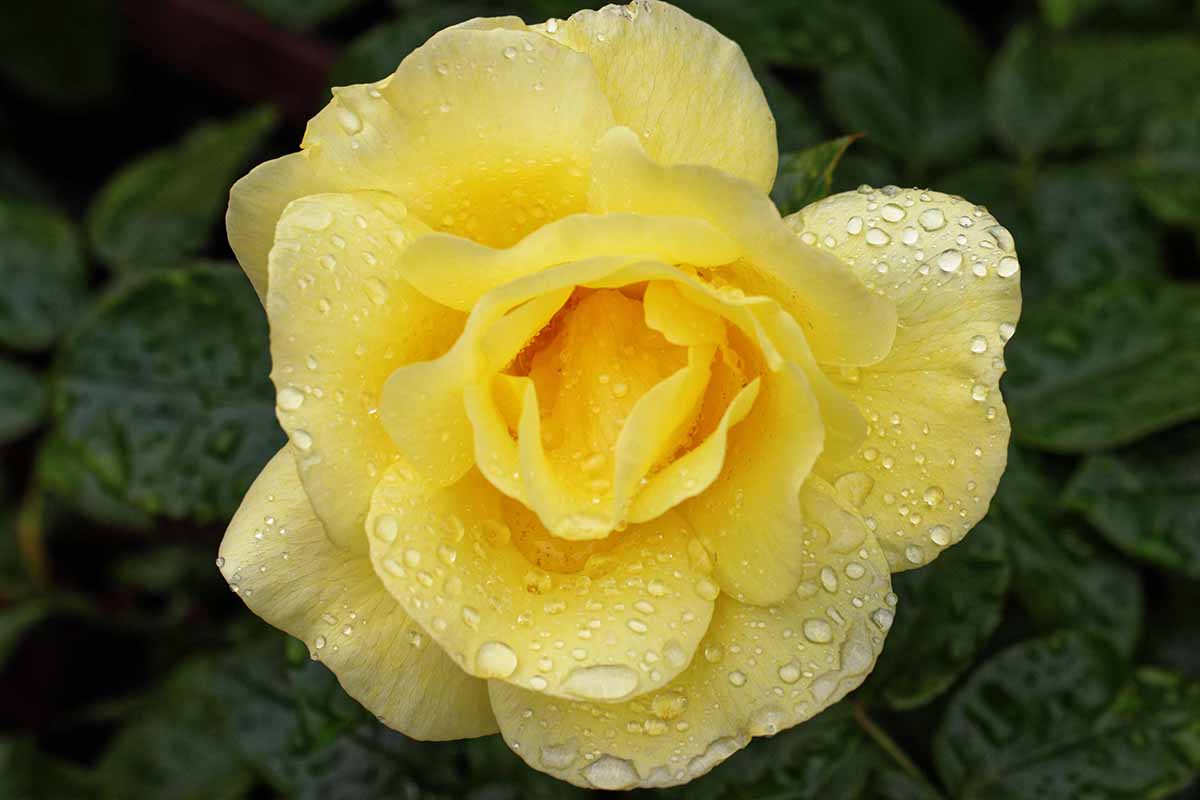
The flowers have a pleasant cup shape and grow singly, so they’re a lovely cutting option too.
This hybrid tea was bred by Dr. Griffith Buck and reaches three feet tall in Zones 4b through 9b.
23. Zephirine Drouhin
It’s nearly thornless, robust, vigorous, and has large, bright pink double blossoms with a heady damask scent. And those bright blossoms? They bloom all season long.

‘Zephirine Drouhin’ can grow rapidly up to 15 or even 20 feet tall in Zones 5b through 10b, and when I say rapidly, I mean it.
I cut mine back to about a foot tall one spring so I could re-shape it, and it had already grown to about three feet tall by early May.
It’s also the first of my two dozen roses to start blooming every year. By mid-May, it’s covered in flowers already.
There’s no question in my mind why this bourbon classic has been popular for years. Nature Hills Nursery carries it in a #3 container.
Put the Chemicals Away
I’m a pain in the butt, I admit it. I don’t want to use chemicals in my garden because fostering a healthy environment is important to me.
But I also want to grow lots and lots of pretty roses. That’s a tall order, but I want what I want.
I get to have both when I grow any of the roses on this list. So can you.
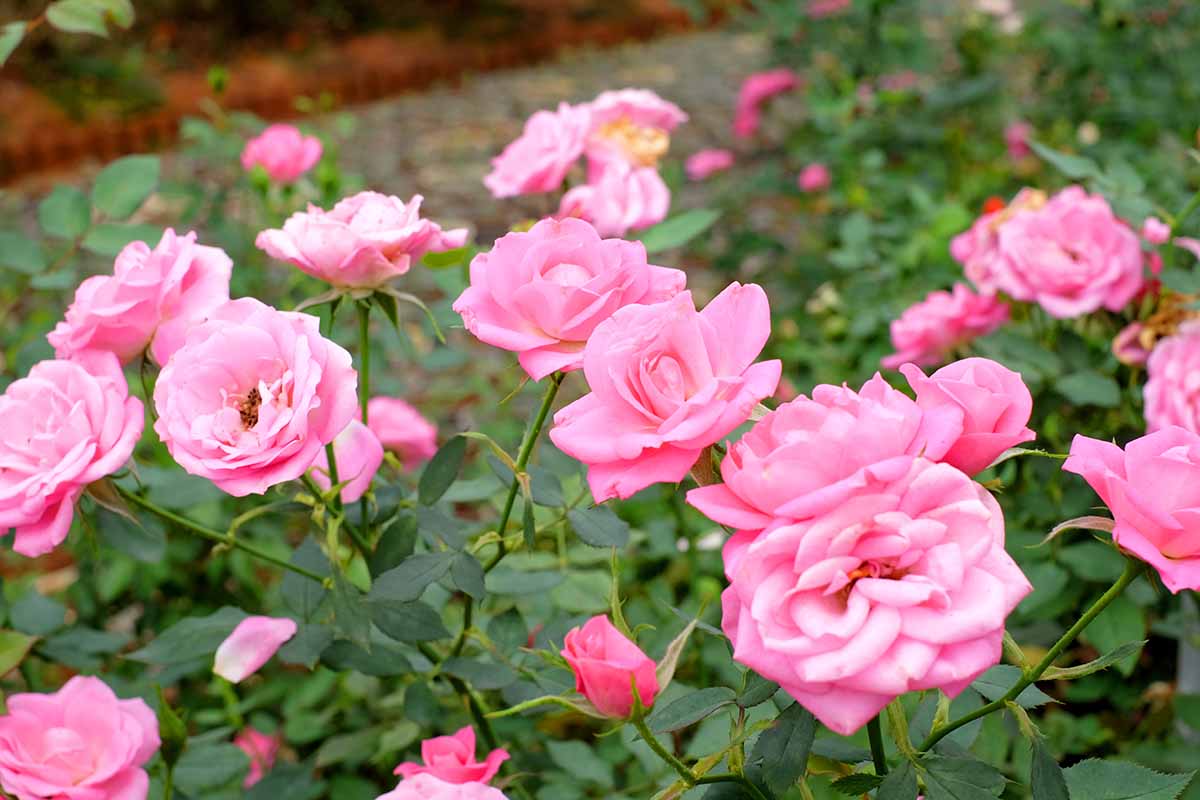
Let me know in the comments if any of the roses in our roundup sound like exactly what you’re looking for. Or maybe I missed an especially tough rose that you love? If so, share it with us!
A truly chemical-free garden starts with picking the right plants, but there’s more to it than that.
You need to keep your roses healthy using every tool at your disposal. Learn how to do just that by reading these guides next:
